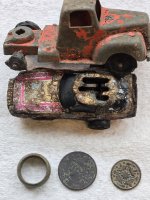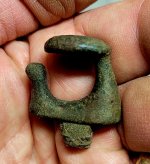RichardGraham
Newbie
- Mar 16, 2012
- 1
- 0
- Primary Interest:
- All Treasure Hunting
i live in the town of oswego, and there are a couple foundations on my property which show signs of a fire burning the buildings down, one appears to be a basement to a house and the other to a barn. i have started metal detecting in there, and clearing debris but so far just nails, horseshoes, hinges, pieces of an old wheelbarrow, lots of rusted cans, a whole bed frame all mangled, lots of broken pottery and some old cobalt blue milk of magnesia bottles, a sickle, axe, saw, and many other things, i am finally nearing what i believe is the floor , because cellar steps stop at that level, so in the next few weeks i will begin my work for this year in there, cant wait to see all the new things to find this year, but i am trying to find more places to look, i have been to a park and to the lakes edge, but i am still trying to figure out what places are best, how to choose locations, what places are rumored to have a big find, even if i only find little things, its the thrill of the hunt i like.






